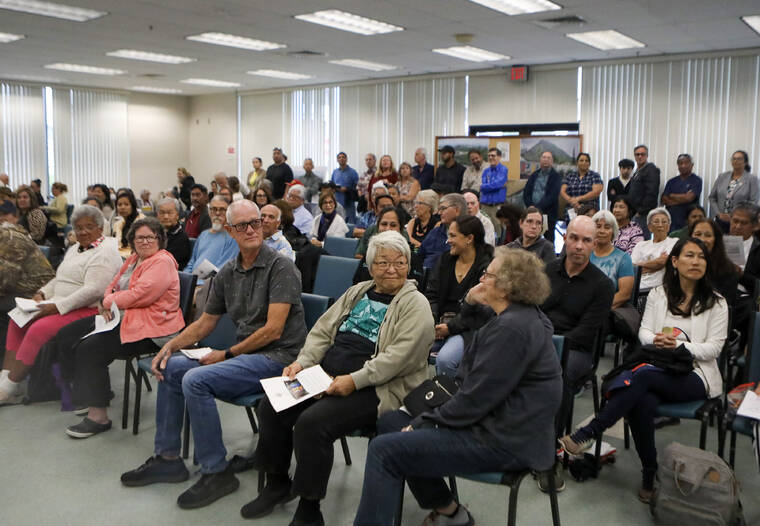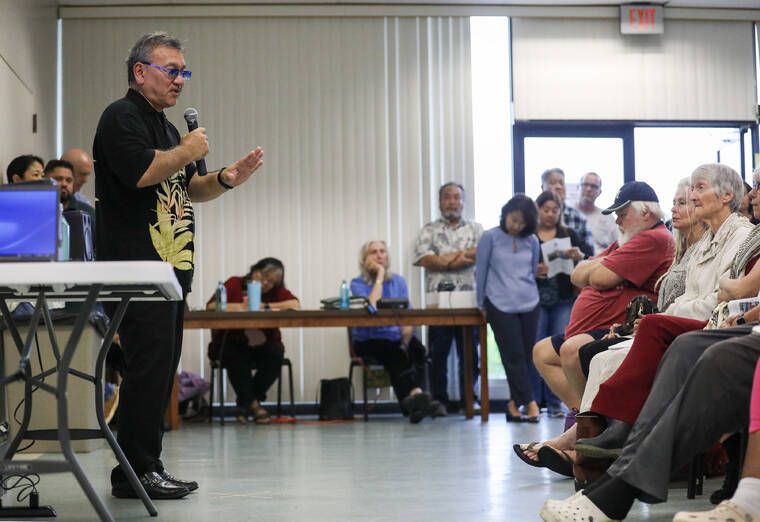Hilo residents were widely enthusiastic Tuesday night during a meeting about a state project to develop communities of tiny homes for the Big Island’s homeless population, despite misgivings about where those communities could be built.
The “Kauhale Initiative” is an effort by the state Office on Homelessness and Housing Solutions to develop small, communal living spaces — called kauhale after a Hawaiian word meaning a group of houses — for houseless individuals in an effort to provide them stability and a path out of homelessness.
The project seeks to develop 12 kauhale statewide over three years. Six of those developments will be on Oahu, with another two each in Maui, Kauai and Hawaii counties.
While no locations for the Big Island kauhale are set in stone, Hilo residents have expressed deep concerns about a site under consideration: a parking lot between the State Building and the Hilo Lagoon Center, directly adjacent to the Wailoa River State Recreation Area.
Some Lagoon Center residents have said the location poses security concerns for the nearby buildings. Others have said the site would be unsafe for kauhale residents, located as it is in a tsunami evacuation zone, and next to a park with high levels of arsenic in the soil.
Driven by those concerns and others, scores of residents packed into the Aupuni Center conference room Tuesday evening for a public information meeting about the kauhale project.
The meeting quickly became standing room only, with attendees overflowing to the sidewalks outside the building.
But OHHS administrator John Mizuno seemed to deftly allay most attendees’ fears about the project. He alluded to the proverbial definition of insanity, noting the state’s previous efforts to address its overwhelming homelessness problem have been either ineffective or have been abandoned.
“It’s a complex issue,” Mizuno said. “My brother was homeless. … He fell on the street, hit his head, and got a brain hemorrhage in 2017. That’s my experience with homelessness.”
Mizuno said that Gov. Josh Green’s vision for the kauhale project is to reduce chronic homelessness by 50% over three years.
Kimo Carvalho, executive director of HomeAid Hawaii, the lead developer of the kauhale project, claimed no other state is investing comparable resources into housing exclusively for homeless individuals.
For each kauhale in Hawaii, Mizuno said safety is OHHS’ primary concern. He said an Oahu kauhale recently was opened in Kanoehe despite concerns from residents about its close proximity to Hakipuu Learning Center, a charter school located just across the street.
However, Mizuno said the Kanoehe kauhale is fenced off and has 24/7 security, and that the kauhale and Hakipuu have a shared garden. Kauhale residents even perform maintenance at the school.
Most of all, Mizuno and Carvalho both emphasized that no Big Island kauhale sites are anywhere beyond a very early stage of consideration. The parking lot site by the Hilo Lagoon Center, for example, would need to go through a multiphase process — including the development of a site plan, access agreements and more — before it could exist, and other sites around Hilo and Kona are being given equal consideration.
Mizuno also explained that people who are checked in to a kauhale will be enrolled in Medicaid and the Supplemental Nutrition Assistance Program, but will also be required to pay rent of roughly $300 to $500 per month after six months in the kauhale.
“There are no free rides,” Mizuno said. “People will still need to work.”
Carvalho estimated singular kauhale units can be manufactured for roughly $16,000 each, and said that the amount of rent required of residents is scaled to be not so high as to prevent them from building up savings but just high enough to motivate residents to work and earn.
“Housing is a huge foundation for everything else,” Carvalho said, adding that, while the individual kauhale units appear small — fitting the definition of “tiny homes” — for homeless people, having any private space that they can keep possessions without being stolen is the first step toward greater stability.
Michael Champion, senior adviser to the governor for mental health and the justice system, said that for people with mental health, behavioral or substance abuse issues, they are more likely to be put in jail than receive appropriate treatment. Carvalho, himself a former Big Island resident, said his biological mother has been homeless and suffered from schizophrenia for years.
When the meeting opened up to public comment, testifiers were unanimously positive about the kauhale concept, with skepticism only arising regarding specific locations.
“I love the idea, let’s do it,” said Cindi Preller, director of the Pacific Tsunami Museum. “Let’s just not do it in a tsunami zone. … If we put (the homeless) in a tsunami zone, then we are not looking out for their health.”
Resident Pat Tummons said that another site under consideration across from the Hawaii Police Department on Kapiolani Street is prone to frequent flooding from upslope runoff, and would be similarly unsafe for kauhale residents.
Another resident, Dexter Aoki, suggested that another site on Wailoa Street near the Lanakila housing project would be ideal for a Hilo kauhale: the site has ample space, already has water service, and is well uphill of the tsunami evacuation zone while still being close to other vital services.
Carvalho said that site is under consideration.
But testifiers all agreed the island’s homeless deserve to be treated with dignity and compassion.
“I was homeless once, and now I am a homeowner,” said resident Ric Parish. “So, I can see things from both perspectives. … We all talk about the ‘aloha spirit.’ I invite you all to live it.”
One testifier, Lopaka Costa, said he curretly is homeless.
“I didn’t expect to be homeless,” Costa said. “I’ve been to every shelter on the island. I went to a private school. College for two years. I never thought I’d be on the streets.”
Email Michael Brestovansky at mbrestovansky@hawaiitribune-herald.com.






